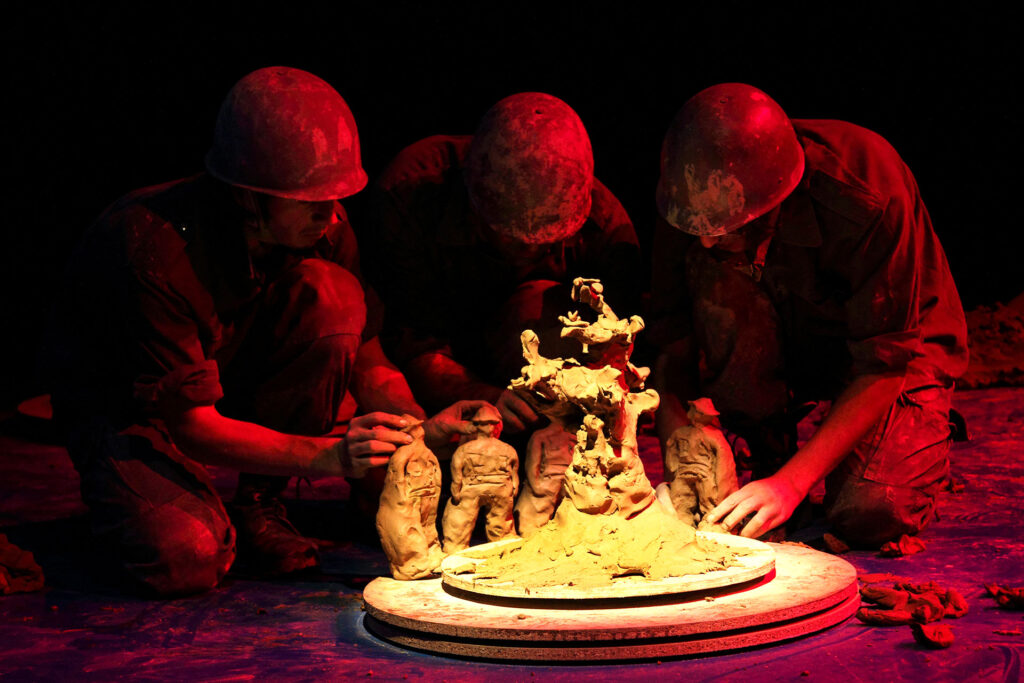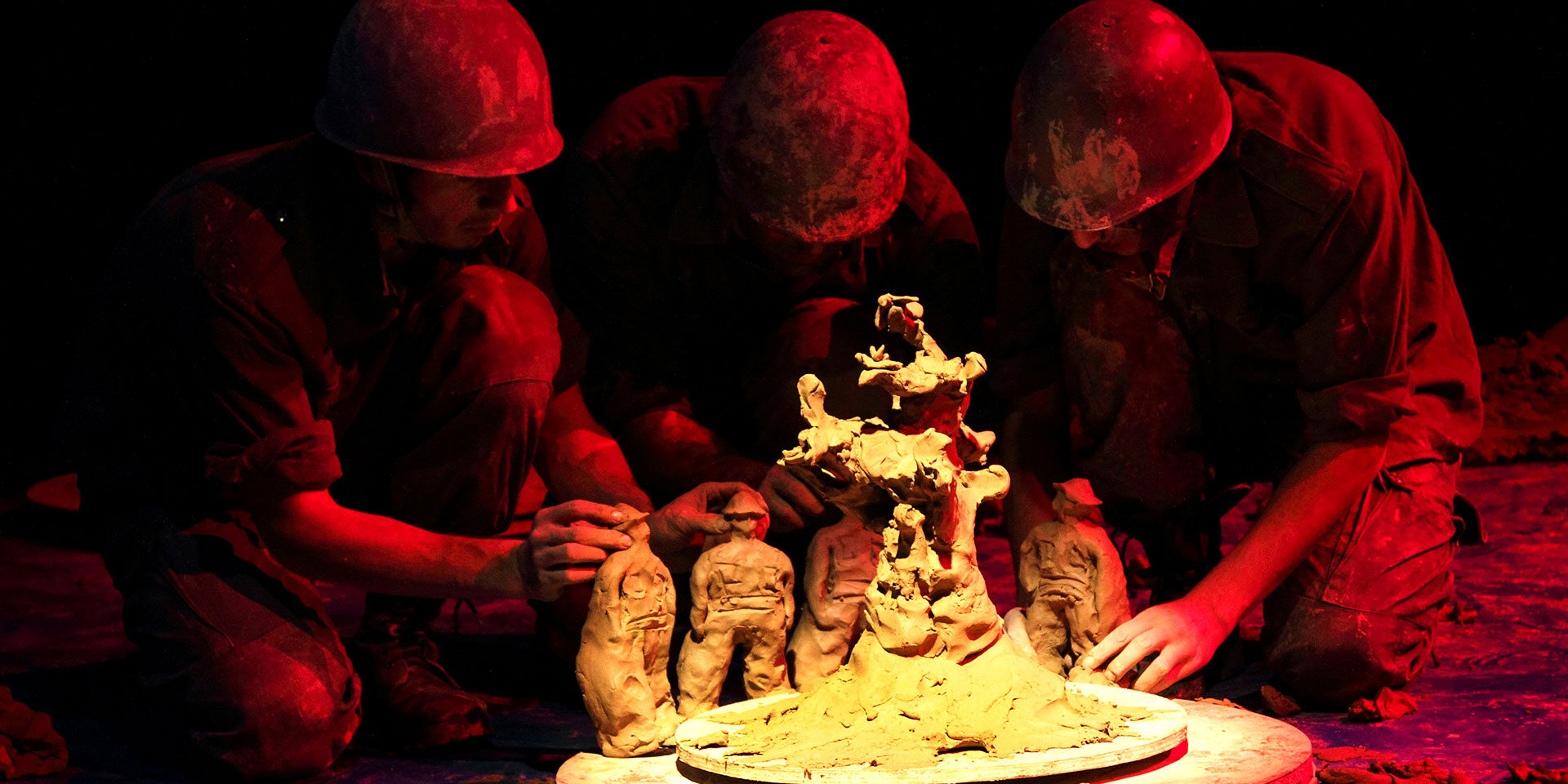Interview with Animatazine website about Count to One theater
HOW DID THE SHOW COUNT TO ONE ORIGINATE, AND HOW DID YOU CHOOSE THE THEME?
Before diving into “Count to One,” I worked on a show called “The Earth and the Universe,” inspired by the profound poetry of the Iranian maestro Muḥammad Rūmī.
As we connected with audiences, first in Iran and then globally, I was genuinely taken aback by their reactions, prompting me to explore another revered Iranian poet: Omar Khayyām.
It’s fair to say that the encouragement from one poet nudged me towards incorporating the verses of another poet into a puppet show.
Rūmī and Omar Khayyām inhabit different poetic realms.
Rūmī, characterized by patience, unfolds narratives meticulously through numerous verses, while Omar Khayyām distills his insights into just two lines.
For this project, I intentionally refrained from reciting or incorporating any of Khayyām’s verses.
The performance features only three soldiers and an abundance of clay.
However, I remain attuned to the sentiments expressed by Khayyām in his poetry.
Even the choice of the show’s title, “Count to One” (highlighting the swiftness of counting to 1 in a second), is a deliberate nod to his succinct style.
According to Khayyām and the essence of our shared human experience, life is transient.
There’s an imperative need to be fully present, disregarding past or future hours and embracing the current moment.
This philosophy forms the cornerstone of my creative contemplation.
While the performance draws inspiration from Khayyām’s entire body of work, the chosen title doesn’t directly mirror any of his specific pieces; rather, it serves as a symbolic encapsulation of his philosophy.
I reflect on Edward FitzGerald, whose translations of Khayyām allowed the world to discover his profound work.
FitzGerald didn’t translate verbatim; he captured the essence.
For those familiar with Khayyām’s verses and mindset, the mere mention of this title evokes an immediate connection with Khayyām’s poetic legacy.

HOW DID THE IMAGE OF THE THREE SOLDIERS IN CONTACT WITH CLAY COME ABOUT?
In my life, I’ve endured numerous hardships due to war.
During my childhood, the revolution erupted, swiftly followed by the outbreak of war.
My aversion to war extends far beyond the borders of Iran, touching every corner of the world.
Khayyām’s philosophy, centered on embracing the present moment, has guided me in profound reflection on life during times of conflict.
If those involved in wars truly lived in the present moment, the world would be devoid of such conflicts.
What deeply captivated my inspiration during my research was the discovery that, if my memory serves me right, a book by Khayyām was found in the trenches during World War II.
The idea that soldiers on the front lines were reading Khayyām profoundly moved my spirit.
A soldier immersed in Khayyām’s writings obviously wouldn’t have the inclination to go and take someone’s life.
So, from the outset, the intention was to portray three soldiers in the trenches, all reluctant to engage in war.
Special attention was given to costume design, avoiding any specific resemblance to the military uniforms of any particular country.
They are simply three soldiers.

WHY DID YOU CHOOSE CLAY AS THE PRIME MATERIAL?
I didn’t choose clay; it was Khayyam who opened this door for me.
Khayyam speaks a lot in his poetry about the earth, clay, and ceramics.
“Then said another: – Surely not in vain
My substance from the common Earth was ta’en,
That He who subtly wrought me into Shape
Should stamp me back to common Earth again.” *
My set design was also inspired by the craft of potters and the wheels they use, but I decided to place them on the ground.
WHAT MESSAGE AND EMOTIONS DID YOU WANT TO CONVEY WITH THE USE OF THIS MATERIAL, CLAY?
The clay instilled a very positive feeling among us from the first attempt, and this atmosphere evolved and gained momentum.
When we stepped onto the stage, we successfully conveyed it to the audience.
Earth is an integral part of every human being’s life, unless they’ve lived on another planet.
I believe it’s an element that forged a powerful connection between the audience and the images we crafted.
At the end of the performances in France, spectators frequently asked me to leave them the clay puppets.
That says something.
I am convinced that those interested in these objects already owned much more sophisticated and captivating pieces at home.
And yet, they felt a kind of honor in taking with them a bird or a soldier from the scene.
Because I think they perceived life within these objects.
A theater director in Iran told me, “You created a miracle. You brought miracles on stage with clay.”
If a miracle happened, it’s thanks to the fusion of two elements, clay, and theater; it’s the combination of clay and theater that works the miracle.
And Khayyām’s poetry, which was crucial in the communicative impact this show had in so many countries.

In the show, each tableau has a name, and one is named “the mother.”
An expectant woman made of clay gives birth with the assistance of the soldiers, delivering a clay newborn.
One of the soldiers draws on one side the symbol of a sun and on the other a moon.
The wheel then starts turning to signify the passage of time.
In the next image, clay is scraped from the mother’s breast and added to the child’s body.
No other clay on stage is used, only that from the maternal body.
And so on.
The mother’s body is scraped, the clay is added to the child’s body.
The child gradually grows.
The mother inexorably approaches death, while the child blossoms into youth.
As the lighting director, I had a strong sense, amidst the audience during the performance, that the women and men present felt a compelling need to pay tribute to their mothers and to life.
In another scene, a king merely gives orders.
Time passes, and this king ages increasingly until his death.
A soldier takes his crown and transforms it into a cushion, tossing it to another soldier who, at that moment, sculpts and animates a beggar.
The beggar takes the cushion, places it under his head, then falls asleep.
Another scene depicts a clay person walking along a clay road.
The wheel turns, and when this person reaches the end of the road, they transform into the road they once traversed.
Numerous images evoke birth and death throughout the performance.

HOW WAS THE SHOW RECEIVED IN IRAN AND INTERNATIONALLY?
It was warmly received during its premiere in Iran.
We performed in a theater that fostered intimacy between the stage and the audience.
I can say that during the arrival and departure of the spectators, their state of mind underwent a significant transformation.
In Poland, the show won the innovation award, accompanied by a financial reward, which obviously was a great help to us financially.
However, it was the award given by the young students that truly left a mark on me, as they wanted to specifically acknowledge the mother’s scene.
This attention, this sentiment they dedicated to that scene, represents for me the most prestigious award I have ever received.
Over time, I adopted a habit as a director, allowing the audience to come on stage after the performance and stay for 30 minutes before leaving.
People are genuinely drawn to the earth.
There’s the power of Khayyām’s poetry, the strength of the show’s construction, the power of the images, but it’s the earth that attracts them.
There’s truly a great mystery in the earth.
Wars erupt over the land.
When I went to perform in other countries, I always carried my clay with me; thus, it was the earth of Iran that I transported as a souvenir to leave elsewhere.
If we truly established a connection between the earth, culture, and art, there would be no war.

HOW HAS THIS SHOW CHANGED YOU AND YOUR TEAM FROM A HUMAN AND ARTISTIC POINT OF VIEW?
At the beginning, I had three performers, three actors stepping onto the stage without the habit of handling such elements, young talents committed to the theatrical action.
Then, over the course of rehearsals, they completely merged with the earth, began a unique process, and developed a distinctly singular approach with the clay.
As for myself, today, I feel an even deeper aversion to war and a greater affection for the present moment.
Let me share an anecdote with you.
One day, during our rehearsals, without really knowing why, I shared with my actors the image of a ballerina performing on stage.
Of course, in Khayyām’s poems, there’s no trace of a ballerina on the horizon.
However, for me, on that specific day, the present moment of these soldiers evoked the presence of a ballerina.
Surprisingly, this scene became one of the most appreciated.
If I delve into my thoughts, my mind immediately questions the reasons for enduring these challenging moments.
However, if I stay anchored in the present, I find myself here with you, the four of us at this moment, exchanging ideas, and I observe the quality of our interactions.
I prepared this show 10 years ago, and its impact still endures today.
WHAT ARE YOU CURRENTLY WORKING ON?
I’m currently delving into the Iranian myth of Arash, a tale that recounts the story of an individual shooting arrows, making a decisive shot that determines his fate, and simultaneously marking the border between the Persians and the Turks.
Unfortunately, in today’s world, borders are often fraught with conflict.
My intention is to direct my focus towards the significance of the border in relation to culture and art, rather than its association with death and war.
I am fully aware of the challenges that lie ahead, but I’ve already initiated this project!
